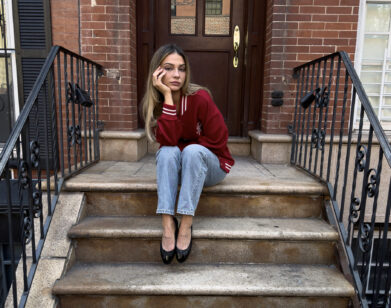Portraits of The Artist

ABOVE: MICHEL HAZANAVICIUS, BÉRÉNICE BEJO, PENELOPE ANN MILLER, AND JEAN DUJARDIN AT LAST NIGHT’S PREMIERE OF THE ARTIST SPONSORED BY HUGO BOSS. PHOTO COURTESY OF MARION CURTIS/STARPIX
“It’s a love letter to the movies!” actress Penelope Ann Miller declared last night at the Peggy Siegal Company premiere of Michel Hazanavicius’ much-anticipated Cannes hit The Artist. Miller was right: The Artist, a film about the period between 1927 and 1932 when silent cinema fell out of fashion, is itself a silent film, shot in black and white—a distribution challenge, to say the least, to which Harvey Weinstein alluded while introducing the film. But there’s leagues more to The Artist than the jokey meta-ness of its narrative: it is an exultant, smart, masterful film that plays constantly on its audience’s expectations, and a strong Oscar contender.
The film itself wasn’t the night’s only surprise: Weinstein also announced before the film that revered Golden Age director Stanley Donen (he of Singin’ in the Rain, Charade, and our own favorite, the sublime, terminally underrated It’s Always Fair Weather) was in the audience, prompting an audible wave of murmurs and instant round of applause. After the film, when its stars Bérénice Bejo and Jean Dujardin came out to join their director, Bejo had a personal message for Donen: “I want to apologize for our dancing,” she said, in deference to the softshoe prowess of Donen’s pals Gene Kelly, Debbie Reynolds, and Cyd Charisse. Later, taking the M5 bus from the Hugo Boss-sponsored screening at the Paris Theatre to the after-party at Forty Four at Royalton, we heard fellow attendees whispering that neither Bejo nor Dujardin had ever danced before, and their impressive dance numbers in the film were the result of a mere six months’ instruction. If it’s true, we’re duly impressed.
Penelope Ann Miller, whose name and face both suggest she’d have been a perfect candidate for silent-era stardom, wasn’t treading entirely unfamiliar territory when she was cast in The Artist. “I did the movie Chaplin with Robert Downey, Jr., and I played Edna Purviance, who was a silent-film actress,” she said. “So I had experience doing a silent film; I watched a lot of Chaplin movies at the time. But I’ve seen Mary Pickford movies, and Clara Bow, and Greta Garbo. I’ve seen so many. I love them.” Miller said today’s actresses could stand to learn a thing or two about “poise and elegance” from the Garbos and Carole Lombards of yore.
Hazanavicius told us that he approached writing The Artist with as strong a sense of what he didn’t want to do as of what he did: “I thought to myself, ‘People will expect something about Charlie Chaplin,’ because it’s silent and in black and white and in the ’20s,” he said. “I was really afraid of that, so I did it the exact opposite: I took a character with power. I mean, he’s a powerful man. He’s not a tramp, he’s not a Charlie Chaplin character. Jean is that kind of actor: very sunny, very energetic.”
Indeed, Dujardin, who plays a silent-era film star whose career takes an unlucky turn when talkies become popular, has a handsome, expressive face more akin to Fairbanks than Chaplin. “I watched a lot of movies,” Dujardin said, in what may have been the understatement of the evening. “Murnau movies, Sunrise, City Girl. I watched a lot of Douglas Fairbanks movies, Gene Kelly’s movies for his smile, for his energy, and Vittorio Gassman for the Italian physicality, and Max Landa, the pioneer of silent movies.”
“It’s more instinctive; it’s not intellectual—your body does the work,” Dujardin continued. Then, with a winning smile: “I had fun pretending to be a movie star!” He won’t be pretending much longer.






